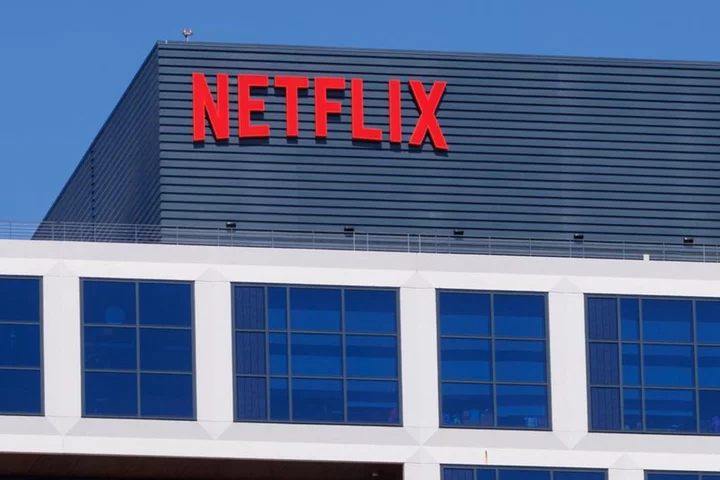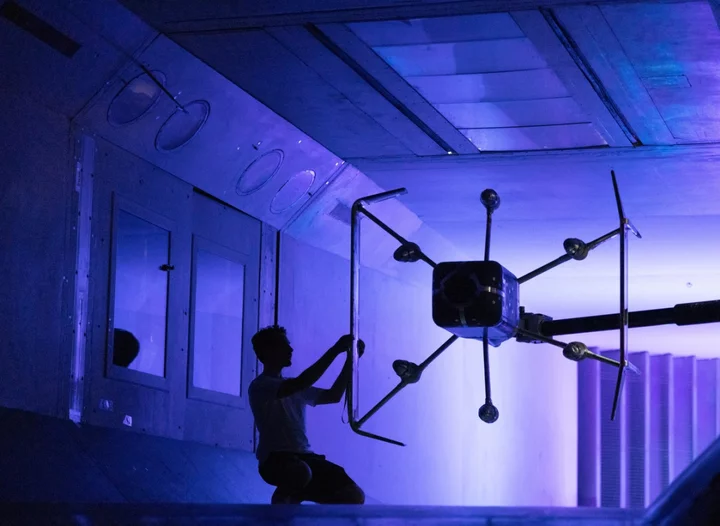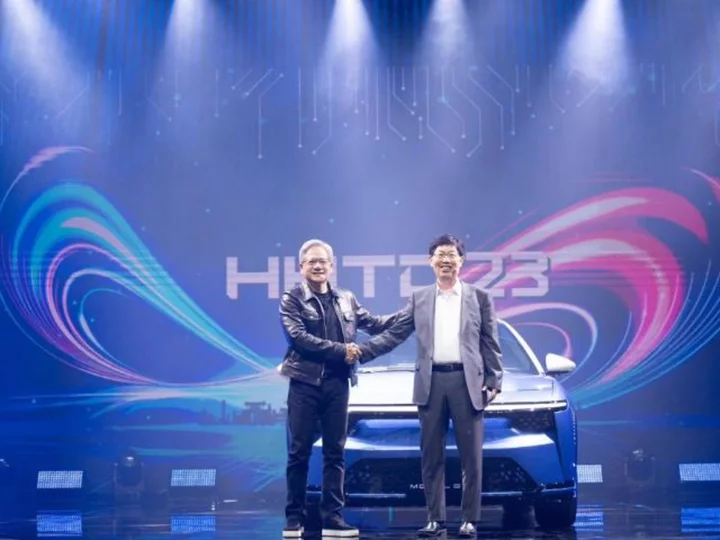
Netflix raises prices as it adds 9 million subscribers
By Lisa Richwine and Dawn Chmielewski LOS ANGELES Netflix raised subscription prices for some of its streaming plans
2023-10-19 04:15

Apple continues its sweep to roll out USB-C to more devices
Apple quietly announced its next-generation Pencil that works with iPads and now includes USB-C charging.
2023-10-19 02:24

Amazon to start dropping packages into people’s gardens using drones in the UK
Amazon says it will soon start using drones to drop packages into people’s gardens from the air in the UK. Customers will be able to make orders and then have Amazon load their packages into autonomous aircraft at its fulfilment centres, the company said. Those drones will then fly to their house, and drop the package into the garden from the air, doing so within 60 minutes, it said. For customers, the drones will be offered alongside the usual set of delivery options, and for no extra price. The deliveries are intended to sit alongside traditional deliveries for when people want small items such as suncream or Fire Sticks quickly, Amazon said. The drones should be launched from new locations by the end of 2024, Amazon said as part of a host of announcements for its plans for Prime Air, its drone delivery arm. It also announced a new drone, which it calls the MK30, which it says is quieter and able to operate in more diverse conditions, such as light rain. Like the existing drones, those new ones are capable of carrying one, 5lb package in a dedicated storage container built into the drone. The package is then ejected out of that container when the drone arrives at the delivery point, which will generally be in customers’ gardens. Amazon stressed that it had looked to build the drones with safety features such as the ability to spot any obstacles, seemingly in an attempt to allay concerns about the danger they may pose, especially in suburban areas. The drone includes technology that will stop deliveries if it spots a pet in the drop-off area, for instance. The drones then fly themselves back to their base, and land vertically just as they take off, on the stands from which they are launched. They can then have their batteries swapped for the next launch. Amazon has already launched drone delivery in two locations in the US, in Texas and California. It says those projects have delivered “thousands” of packages in the last 12 months since those projects launched. But it will now launch a similar scheme in the UK, as well as in Italy and at another US location, by the end of 2024. It has not said exactly where those drones will fly from, but suggested that it will do so soon. The drones will be able to fly out to about 12 kilometres from their base, which will be located in one of the UK’s fulfilment centres. The location has been chosen and will be announced in a “couple of months”, he said. The company intends to expand the rollout after that, however, with Amazon’s head of Prime Air telling The Independent that there is a “mapped-out plan” to open more facilities over time. “This is not a market test,” he said. That is part of a plan to increase deliveries from thousands now to hundreds of millions by the end of the decade. “Our vision for a successful delivery solution for our customers, who really want their packages faster, is to be able to deliver 500 million packages by the end of the decade to customers in highly-populated, dense urban areas,” Mr Carbon said. Mr Carbon said that Amazon had chosen the UK for its next expansion in recognition of its aerospace heritage, as well as Amazon’s large footprint in the country and high demand from customers. He also said that Prime Air had a “great legacy” in the country, with the first ever successful Amazon drone delivery happening in Cambridge in 2016, though its operations have been scaled back in the country since. Showing off Amazon’s work on drones to reporters in Seattle, Mr Carbon said that much of the recent work had gone into safety features, and he said the new drones were certified in the same way as traditional planes. Amazon’s current drones are twice as safe as driving to a physical store to pick up an item, he said, and the upcoming MK30 is “two orders of magnitude” safer than making that journey. He suggested that part of the reason for expanding the drone network was to reduce the number of cars making deliveries in busy cities, as well as reducing the need for panicked and potentially unsafe journeys to shops when people need ultra-fast deliveries. But he also said that there was “absolutely” a demand for such quick deliveries from customers. It was clear that customers “want stuff fast”, he said. Amazon is “committed to taking technology, finding technology, developing technology” to make the experience of deliveries better in response, he said. Amazon has not said how much the drone project has cost in the more than a decade it has been in operation. It also would not say exactly how many drones are in its fleet, or give any information the economics of the flights, such as how many deliveries would be required for it to be profitable. But he did stress that the new rollout is “not about proving that you can deliver a package by drone” and is not a pilot or a test scheme, but a real rollout of the technology with a view to making it widespread. He did say however that it would “start slow” to increase the chances of success. The UK has its own regulatory framework, and Amazon said it had been working with regulators and the government to ensure the drones are ready to launch by the end of next year. But it also comes with its own challenges, such as dense urban areas, fewer gardens and less use of the grid system that can make US neighbourhoods easier to map. Mr Carbon said that Amazon had designed the drone and the other systems that support its journeys to be able to do so in a range of different environments. The drone “has been designed to cope with where our customers are”, he said. Amazon was unable to say what restrictions it expected regulators to put on the drones’ flights, such as weather they would be allowed to cross roads and whether someone would need to have sight of it at all times. It said that it was working on technologies to give the drones more capabilities – such as the ability to autonomously spot and avoid obstacles – with the hope that those would allow for less restrictions. UK regulator the Civil Aviation Authority suggested that Amazon’s work would lead to changes such as the ability for commercial flights to operate without being watched by their pilot. “Exploring the options of how drones can be safely and successfully incorporated into more of the UK’s airspace is key,” Frederic Laugere, head of innovation advisory services at the UK Civil Aviation Authority. “It is vital that projects such as this take place to feed into the overall knowledge and experiences that will soon enable drones to be operating beyond the line of sight of their pilot on a day-to-day basis, while also still allowing safe and equitable use of the air by other users.” The new locations are just one part of a plan to bring the deliveries to “as many Amazon customers as our technology can safely enable”, Amazon said in its announcement. It plans to “soon” launch from “new cities, countries, and continents”, it said. Read More Facebook has stopped working Facial recognition firm Clearview AI overturns UK data privacy fine New AI can tell if you have diabetes after just 10 seconds of listening to your voice Facebook has stopped working Facial recognition firm Clearview AI overturns UK data privacy fine New AI can tell if you have diabetes after just 10 seconds of listening to your voice
2023-10-19 01:20

Facebook down: Social network not working as users stopped from posting
Facebook has stopped working, with users complaining they are unable to post. Many feared that they had been banned from using the site. But the problems appear to be related to technical issues. Other platforms owned by parent company Meta – such as WhatsApp and Instagram – appeared to be functioning as usual. Meta has recently been working to integrate the infrastructure of its different social networks, which seemingly means that they occasionally go offline at the same time. Some parts of Facebook also appeared to be working as normal, at least for some users. Facebook users complained particularly that posting appeared to be broken, even as other parts of the site worked. That led many to fear that they had been blocked from posting on the site because of some unknown infringement of the rules. On tracking website Down Detector, many said they were worried they had got in trouble until they saw details of the outage. Meta does not operate an official status page for its customer-facing products. It does offer one to businesses, which showed no current issues at the time of publication. Read More Facebook’s new AI sticker tool generates ‘completely unhinged’ images Facial recognition firm Clearview AI overturns UK data privacy fine New AI can tell if you have diabetes after just 10 seconds of listening to your voice
2023-10-19 00:52

Amazon rolls out robotic system at Houston warehouse to speed up deliveries
Amazon.com said on Wednesday it was using a robotic system at one of its Houston warehouses to improve
2023-10-18 23:19

New AI can screen for diabetes in seconds by listening to your voice
Scientists have discovered a way to test whether someone is diabetic by having them speak just a few sentences into their smartphone. A team from US-based Klick Labs created an AI model capable of distinguishing whether a person has Type 2 diabetes from six to 10 seconds of voice audio, with tests revealing an 89 per cent accuracy rate for women and 86 per cent for men. “Our research highlights significant vocal variations between individuals with and without Type 2 diabetes and could transform how the medical community screens for diabetes,” said Jaycee Kaufman, a research scientist at Klick Labs. “Current methods of detection can require a lot of time, travel and cost. Voice technology has the potential to remove these barriers entirely.” The study involved analysing 18,000 recordings in order to identify acoustic features that differentiated non diabetics from diabetics. Using signal processing, they were able to detect subtle changes in pitch and intensity that are imperceptible to the human ear. The tool could prove useful for the estimated 240 million adults around the world who are currently living with the condition without realising, according to figures from the International Diabetes Federation. The latest research demonstrates the ever-growing role AI plays in healthcare, with the convergence of machine learning models, data science helping to improve patient treatment and assisting medical discoveries. The researchers claim the artificial intelligence model, which requires basic health data from the subject in order to determine whether they are diabetic, could be expanded to diagnose other health conditions. “Our research underscores the tremendous potential of voice technology in identifying Type 2 diabetes and other health conditions,” said Yan Fossat, vice president of Klick Labs and leader of the research. “Voice technology could revolutionise healthcare practices as an accessible and affordable digital screening tool.” The technology was detailed in a study, titled ‘Acoustic analysis and prediction of Type 2 Diabetes Mellitus using smartphone-recorded voice segments’, published in the journal Mayo Clinic Proceedings: Digital Health. Read More 10 ways AI will change the world – from curing cancer to wiping out humanity
2023-10-18 22:58

New King Kong game is being torn apart by the internet
The new King Kong video game, Skull Island: Rise of Kong, has released to an awful reception, with some naming it as the 'worst game of the year'. A new beat-em-up starring colossal kaiju favorite King Kong, flying in under-the-radar? You might be thinking 'sign me up' for a bit of that. If you're thinking that, you might want to hold back. Skull Island: Rise of Kong was only announced in July, and is available on PlayStation 5, Playstation 4, Xbox Series X/S, Xbox One, Nintendo Switch and PC, and come to think of it, there wasn't a great deal of promo heralding its release at all. That all makes sense now. The game is flat-out terrible, and the only noise being made about it is being generated by gamers who are ripping the new release apart with footage of the game and its cutscenes being shared far and wide. A quick snapshot of user reviews shows Skull Island: Rise of Kong being named as janky, terrible, static, awful, buggy and a 'complete scam' - the professional reviews (and we'll get to those) aren't much better at all. And users really think it could beat Lord of The Rings: Gollum to the title of 'worst of the year.' In particular, one cutscene involving a JPEG flashback/jumpscare is generating a lot of attention. All of it mocking the presentation of the game: It's not just gamers who are taking shots either, the gaming press is savaging the new release. Kotaku said the 'New King Kong Game Is Very, Very Bad' and called it a 'bland beat-’em-up with bad cutscenes, nasty visuals, and not much else' while Eurogamer called it a 'swing and a miss.' Fans of the great ape had been waiting a long, long time for a video game featuring Kong. The official video game of Peter Jackson's King Kong film titled - wait for it - Peter Jackson’s King Kong: The Official Game of the Movie came out in 2005 over a mix of consoles. You could've played it on Playstation 2, it has been that long. It's sad to say, but you'd be better off finding a way to play the older game. It's far, far better - and we can vouch for that. Sign up to our free Indy100 weekly newsletter Have your say in our news democracy. Click the upvote icon at the top of the page to help raise this article through the indy100 rankings.
2023-10-18 20:16

Adobe creates futuristic 'quick change' dress that could end fast fashion
Adobe have unveiled a mind-blowing 'quick change' dress at their recent Adobe Max conference, and no one can quite believe how the future of fashion could look. Christine Dierk, a researcher, unveiled the seemingly ordinary dress, before showing how it can transform colour and pattern within a split second, with limitless options. "We’re excited for a future where there’s more ways to express yourself", she told the audience, as she demonstrated the product known as 'Project Primrose'. The company is reportedly hoping to replicate the technology onto other items. Sign up to our free Indy100 weekly newsletter
2023-10-18 19:58

Flat Earthers attempted to sail to the edge of the world – and it ended in massive disappointment
Despite no evidence backing up their claims, Flat Earthers are adamant that they are correct when it comes to the shape of our Earth. Even when their own evidence disproves them, it seems. Back in 2020, a couple from Venice tried to prove the world was flat by setting sail to the edge of the world, which they believed was somewhere near Sicily, after a planned Flat Earthed cruise to Antartica was cancelled due to the Covid-19 pandemic. The couple violated the lockdown restrictions in place at the time of their travels, selling their car in order to buy a boat. Using a compass, a device that works because the Earth is round, the pair set off in their boat to reach Lampedusa. However, it was not long until they found themselves lost, tired, and on the island of Ustica instead. Salvatore Zichichi of the Maritime Health Office of the Ministry of Health told Italian newspaper La Stampa: "For them, Lampedusa [an island of the Italian Pelagie Islands in the Mediterranean Sea] was the end of the Earth." "The funny thing is that they orient themselves with the compass, an instrument that works on the bass of terrestrial magnetism. A principle that they, as Flat Earthers, should reject." They were placed in quarantine by health officials due to the ongoing pandemic at the time, but the couple escaped and sailed away in pursuit of the edge of Earth. Three hours later, they were caught. The pair tried to escape one more time but failed, and abandoned their plan, taking a ferry back to mainland Italy once their time in quarantine was fulfilled. Sign up to our free Indy100 weekly newsletter Have your say in our news democracy. Click the upvote icon at the top of the page to help raise this article through the indy100 rankings.
2023-10-18 19:27

Taiwan's Foxconn to build 'AI factories' with Nvidia
Taiwan's Foxconn says it plans to build artificial intelligence (AI) data factories with technology from American chip giant Nvidia, as the electronics maker ramps up efforts to become a major global player in electric car manufacturing.
2023-10-18 18:46

ChatGPT creator quietly changes core values from ‘thoughtful’ to ‘scrappy’
ChatGPT creator OpenAI has updated its company’s core values, replacing words like “thoughtful” and “collaborative” with “intense and scrappy”. The AI firm’s values, published on a careers page of its website, were changed between 25 September and 16 October, according to a screenshot captured by the Internet Archive. The top value is listed as “AGI focus”, referring to artificial general intelligence that is considered to be at the same level or greater than human-level intelligence. “We are committed to building safe, beneficial AGI that will have a massive positive impact on humanity’s future. Anything that doesn’t help with that is out of scope,” the new values state. The Independent has reached out to OpenAI for comment on whether the move signals a shift in company direction. The update, first spotted by Business Insider, comes amid an industry-wide push towards the development of AGI, with some academics and experts accelerating their timelines for it being achieved since the launch of ChatGPT last year. Forecasts suggest that the arrival of AGI could be hugely destabilising for the global economy, with some even warning that it could pose an existential threat to humanity. Swedish philosopher Nick Bostrom, based at Oxford University, previously warned that the arrival of AGI would precede so-called superintelligence, whereby computer intelligence surpasses human intelligence and AI development becomes uncontrollable and irreversible. In one thought experiment involving a rogue AI, Mr Bostrom wrote: “The AI will realise quickly that it would be much better if there were no humans because humans might decide to switch it off.” OpenAI has consistently called for a careful approach to the development of such technology, arguing that it could have profound implications for society, like curing diseases and turbocharging the economy. Last month, OpenAI chief executive Sam Altman wrote in a post on Reddit that his company had achieved AGI “internally”, however he later claimed that it was just a joke. “Obviously this is just memeing, y’all have no chill, when AGI is achieved it will not be announced with a Reddit comment,” he wrote. Read More The mystery AI device that could replace your phone The mystery AI device that could replace your phone Elon Musk’s X may charge some users $1 a year to post on platform Apple just released a new Pencil after days of excitement
2023-10-18 18:21

Experts unravel mystery of the Pokémon episode that hospitalised hundreds of kids
Pokémon’s TV series has been delighting animé lovers for more than 26 years, and yet, there’s one episode that even the most diehard of fans may well have missed. The installment, titled Dennō Senshi Porygon (which roughly translates as "Computer Warrior Porygon”) aired in Japan on December 16, 1997. And, after that single, fateful outing, it was never to grace television screens again. The reason for the ban? Reports of a strange health outbreak among children which was linked to a specific scene. The episode follows Ash Ketchum, Pikachu and their pals as they investigate a faulty Poké Ball transfer machine by getting inside it. Once there, the team come under attack, but are saved when Pikachu unleashes one of his high-octane electric outbursts – represented by a barrage of red and blue strobe lights. And that’s where the trouble began. According to scientific paranormal investigator Benjamin Radford and sociologist Robert Bartholomew, who dedicated a study to the event: "At 6:51 PM, the flashing lights of Pikachu's 'attack' appeared on television screens. “By 7:30 PM, according to Japan's Fire-Defense Agency, 618 children had been taken to hospitals complaining of various symptoms." These symptoms included convulsions, nausea and vomiting, with news of the “illness” spreading rapidly throughout the country. Inevitably, it made headlines, with several news broadcasters replaying the offending clip, “whereupon even more children fell ill and sought medical attention,” Radford and Bartholomew wrote. The following day, TV Tokyo issued an apology, suspended the show, and announced an investigation into the cause of the seizures. Meanwhile, video retailers pulled the series from their shelves, and even the then-prime minister Ryuaro Hashimoto expressed concern at the use of rays and lasers in the popular cartoon. Within two days, the number of children reported to have been affected by the flashing sequence increased to around 12,700. And yet, after four months of investigation – with input from health experts and Japanese government officials – no obvious cause could be found for the outbreak and Pokémon returned to the airwaves. Because, although the bright flashes were assumed to be the cause of the health panic, such visual techniques had been used in numerous other animé episodes before, with no reports of any problems. So what was going on here? Well, a tiny fraction of the children who reported being affected were diagnosed with photosensitive epilepsy, with experts concluding that the rapid colour changes during the scene caused them to suffer seizures. However, the bulk of “patients” reported symptoms that had no identifiable “organic” cause and were, instead, consistent with a very different type of condition… Mass hysteria. Radford and Bartholomew attribute this “epidemic hysteria”, in large part, to the mass media, which they say fuelled panic and misinformation. "Many of the children's symptoms had no identifiable organic basis; other than the verified cases of seizures, the symptoms reported were minor and short-lived; the victims were nearly exclusively school children in early adolescence; and anxiety from dramatic media reports of the first wave of illness reports was evident,” they wrote. “Media reports and publicity fuel the hysteria as news of the affliction spreads, planting the idea or concern in the community while reinforcing and validating the veracity of the illness for the initial victims,” they continued. “According to news accounts of the time, the number of children said to be affected remained around 700 the evening of the Pokémon episode and the next day. “The next morning, the episode dominated the Japanese news. Japanese children who had not heard about their peers from the news or from their parents learned of it that morning when the seizures ‘were the talk of the schoolyards’,” they continued. “Once the children had a chance to hear panicky accounts of what had happened through the mass media, their friends and their schools, the number of children reported the next day to have been initially affected – 2 days earlier – increased by 12,000.” Radford and Bartholomew ended their paper by noting that this Pokémon drama offers a warning to us all. They pointed out that our continuing reliance on mass communications, especially TV and the internet, places us at risk of more and more hysteria outbreaks. “Technological innovations are occurring at unprecedented rates and have the potential to influence significant numbers of people beyond the typical number in traditional mass hysteria episodes,” they stressed. “Epidemic hysterias that in earlier periods were self-limited by geography now have free and wide access to the globe in seconds.” Concluding on an ominous note, they added: “The Pokémon illness symptoms are without precedence, given the large numbers affected, and may be a harbinger of future technological hysterias that have the capacity to affect unprecedented numbers of people at a phenomenal speed.” Sign up for our free Indy100 weekly newsletter Have your say in our news democracy. Click the upvote icon at the top of the page to help raise this article through the indy100 rankings.
2023-10-18 17:26
